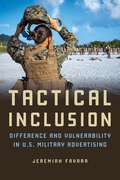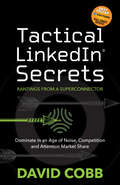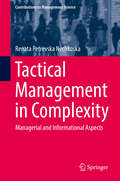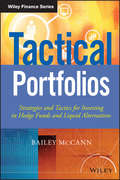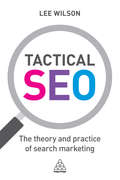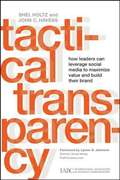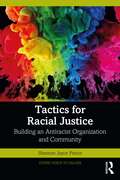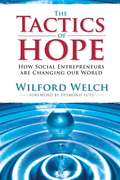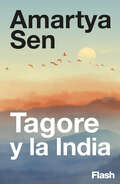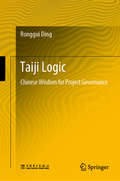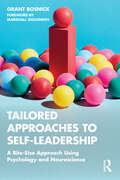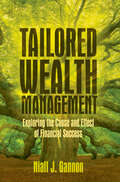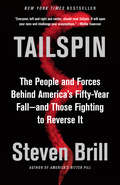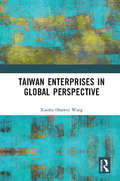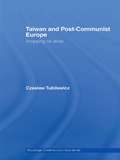- Table View
- List View
Tactical Inclusion: Difference and Vulnerability in U.S. Military Advertising (Feminist Media Studies)
by Jeremiah FavaraThe revolution in military recruitment advertising to people of color and women played an essential role in making the US military one of the most diverse institutions in the United States. Starting at the dawn of the all-volunteer era, Jeremiah Favara illuminates the challenges at the heart of military inclusion by analyzing recruitment ads published in three commercial magazines: Sports Illustrated, Cosmopolitan, and Ebony. Favara draws on Black feminism, critical race theory, and queer of color critique to reveal how the military and advertisers affected change by deploying a set of strategies and practices called tactical inclusion. As Favara shows, tactical inclusion used representations of servicemembers in the new military to connect with people susceptible to recruiting efforts and rendered these new audiences vulnerable to, valuable to, and subject to state violence. Compelling and eye-opening, Tactical Inclusion combines original analysis with personal experience to chart advertising’s role in building the all-volunteer military.
Tactical LinkedIn® Secrets: Rantings From a Superconnector: Dominate in an Age of Noise, Competition and Attention Market Share
by David CobbTactical LinkedIn® Secretsteaches business professionals how to dominate in an age of digital noise and competition.
Tactical Management in Complexity: Managerial and Informational Aspects (Contributions to Management Science)
by Renata Petrevska NechkoskaThis book draws on the author’s own experience as a practitioner, collaborations with professionals from small and medium-sized businesses with international scope in North Macedonia and Belgium, and academic research. Its goal is to bring together tactical management and information systems research in complex environments. By developing the “DENICA” managerial method it re-introduces tactics as an important managerial function and underestimated source of competitive advantage. The book also offers a roadmap for dynamic reconfiguration of the managerial systems in complex environment, while considering adaptability, sustainability and effectiveness in the process. Furthermore, the book introduces a methodological “kaleidoscope” which combines IS methodology with the managerial sciences, offering a model that can be adapted and replicated to specific contexts in order to achieve fitting solutions. Real-world case studies from North Macedonia and Belgium apply these methods and illustrate their practical implications.
Tactical Portfolios
by Bailey MccannTake an active management approach with liquid alternatives to increase R.O.I.Take advantage of inefficiencies in the market by investing in alternative assets. Hedge fund and private equity investment diversifies your portfolio and helps shield you from market volatility, allowing your more passive assets to work the long game. In Tactical Portfolios: Strategies and Tactics for Investing in Hedge Funds and Liquid Alternatives, author Bailey McCann guides you through the principles of hedge fund investment and the associated philosophies of risk management strategies. McCann's background in reporting and analyzing government policy and regulatory issues positions her as a valuable source of strategic investment advice. As Senior Editor of Opalesque's Alternative Market Briefing, her take on the market is read by every one of the top 100 hedge fund managers on a daily basis. In Tactical Portfolios: Strategies and Tactics for Investing in Hedge Funds and Liquid Alternatives, McCann goes in-depth on important topics.Strategies for equities, managed futures and fixed incomeWhat to expect and common misconceptionsInvestment mechanics of specific strategiesValuation, red flags, and regulatory changesIf your passive approach has failed to produce the desired results, liquid alternative investment may be the answer. While long/short will always be around, external forces can change its impact on your portfolio and it may be time to expand your investment arsenal. Tactical Portfolios: Strategies and Tactics for Investing in Hedge Funds and Liquid Alternatives will help you get the most out of any market.
Tactical SEO: The Theory and Practice of Search Marketing
by Lee WilsonSearch engine optimisation is an increasingly critical tool for digital marketers in a competitive and saturated online marketplace. Setting itself apart from the ubiquitous technical and process-driven guidance, where tips and tricks which are quick to date, Tactical SEO moves towards a deeper understanding of search marketing and the industry as a whole. These insights will help you to truly grasp the opportunities, challenges and value that SEO can bring to an online presence in the long term leading to a more strategic and nuanced approach.Tactical SEO explores:· what succeeds in search marketing but also why, including analysis of 'ripples' and other concepts that underpin best practice.· moving from process-driven to organic search marketing and the value of exploiting opportunity.· the Google ethos and the symbiotic nature of Google and SEO.· how a value-checklist can re-focus your strategy and generate positive results.Essential reading for practitioners and students, Tactical SEO provides thought leadership as well as strategic practical applications for those who want to develop real and lasting expertise.
Tactical Transparency
by Johnson Lynne D. Havens John C. Holtz ShelWhile exposing the risks inherent in maintaining a nontransparent relationship with customers, Tactical Transparency provides a methodology that will help your organization create its unique plan to bring greater authenticity to your company and your brands. Drawn largely from interviews with leaders in companies that have achieved measurable success in this arena, authors Shel Holtz and John C. Havens provide step-by-step details on how executives and professional communicators can create a transparency strategy that will keep their organization competitive in the twenty-first century. The authors show how organizations can evaluate their readiness for transparency, what they need to do to get ready, and how to effectively communicate their transparency strategy to their customers and employees. They also identify aspects of blog/new media "netiquette" an important but often misunderstood part of engaging in transparency. Your purchase of Tactical Transparency Includes a One Year Subscription to Fast Company ($10 value). View the refund/promotion details here.
Tactics for Racial Justice: Building an Antiracist Organization and Community (Giving Voice to Values)
by Shannon Joyce PrinceThis is not a book of antiracist theory but antiracist tactics – tactics that anyone, of any race, can use to strike a blow against injustice. Antiracism is not about what we feel but what we do, and there are specific techniques we can use to create a just world. Antiracist strategies are skills that can be learned just as we learn skills for public speaking or hitting a baseball. In these pages, you – whether a person of color or white – will find a playbook for leading your workplace, organization, or community through transformative change in the wake of an act of explicit racism. You’ll learn to play antiracist rhetorical chess, and to anticipate and effectively respond to the discursive moves of people who don’t understand bigotry, aren’t aware of it, are in denial of it, or even actively uphold it – so that you can advance justice goals. You’ll get a blueprint of how to dismantle systemic racism community by community, workplace by workplace, and organization by organization – and examples of what not to do. This book is aimed at people who are conscious of the reality of racism and want to end it but may not know how. It clearly shows how anyone can make an effective, significant, and measurable impact on racism through strategic action.
Tactics of Hope
by Wilford WelchTactics of Hope is Welch's call to action, driven in part by the frustration with the priorities and pace at which the current players on the world scene are addressing issues, such as extreme poverty, human rights and the environment. Out of this frustration, however, came a major gift-the gift of hope and possibility. Worldwide participants, chronicled in this book ,are inspired and inspiring, and the organizations and individuals involved are doing impressive and effective work. One business leader contributed desperately needed computers to schools in Cambodia; two individuals teamed up to teach conflict resolution in South Africa; another volunteered to fund ongoing dialogues between the Palestinians and Israelis. Presented in each chapter are new visions of what is possible and realized that global public opinion and individual initiative might indeed become the world's second super-power and help bring about change in global priorities.
Tactics of Influence: Three Ways to Project Influence
by Richard LueckeThis chapter examines three tactics for transforming power into influence: framing, information, and technical authority. Each is a practical mechanism for influencing others.
Tad O'Malley: June 2005
by Josh Lerner G. Felda Hardymon Ann LeamonTad O'Malley, a new associate at Empire Investment Group, a top-tier leveraged buyout firm, must evaluate three different deals and recommend which should receive additional resources for further investigation. He must consider the specifics of each company and each deal as well as the resources or restrictions of the firm's offices that would handle the project.
Tad O'Malley: The Investment Conundrum
by Josh Lerner G. Felda Hardymon Ann LeamonTad O'Malley has just started as an associate with Empire Investment Group. He must evaluate three investment opportunities facing the big leveraged buyout firm. All are global, but each pertains to different offices and each deal has different strengths and weaknesses. Which should he recommend to the partners for additional resources and what does a recommendation mean for his career?
Tad Piper and Piper Jaffray
by Andrew N. Mclean William W. GeorgeIn 2005, Tad Piper reflects on the successful spin-off from US Bancorp of Piper Jaffray, the investment bank founded by his grandfather. Profiles the development of Piper Jaffray from a Midwestern brokerage house to a national, diversified financial services firm. In 1994, a crisis in its mutual fund unit nearly destroyed the firm. Provides information about the protagonist's youth, career, family life, aspirations, and motivations. Raises questions about leadership in times of crisis, openness with stakeholders, and the value of showing vulnerability as an authentic leader.
Tagore y la India
by Amartya SenUna apasionante semblanza del Premio Nobel de Literatura más desconocido. Premio Princesa de Asturias de las Ciencias Sociales 2021 Premio Nobel de Economía 1998 Existe un auténtico contraste entre la presencia intelectual de Rabindranath Tagore en la literatura, la política y la sociedad bengalíes y su imagen de gurú espiritual que llegó hasta Occidente. Entre ambas facetas se abre un amplio espacio surcado por numerosos debates en torno a la religiosidad, el sistema de castas y la independencia que llevaron a considerarlo en India una de las personalidades más polifacéticas y preeminentes del siglo XXI. Amartya Sen recorre en esta breve semblanza las piedras angulares del argumentario del pensador bengalí, un escritor de elegante prosa y mágica poesía, y redescubre a los lectores occidentales al Tagore más oculto: el concienciado activista, el pintor de enorme talento y el gran estratega político. «Rabindranath sabía que no habría podido brindarle a la India el liderazgo político que Gandhi le confirió, y nunca hubo ironía en su reconocimiento de lo que Gandhi hizo por la nación (de hecho, fue Tagore quien popularizó el tratamiento de Mahatma —alma grande— para Gandhi)».
Taiji Logic: Chinese Wisdom for Project Governance
by Ronggui DingThis book illustrates the Chinese wisdom hidden behind the project governance which is called “Taiji logic”. “Taiji logic” is a set of dialectical ideals and approaches that are unique in the Chinese culture. The three pillars of “Taiji logic” are: identifying the conflicts based on the principle that Yin - Yang are not only opposite but also unitary, capturing the best time to reconcile conflicts with the laws of transformations of Yin - Yang, and finally, symphonizing conflicts with “Zhong-Yong” ideas to balance the needs of various stakeholders. This book aims to solve key issues in project governance from a special Chinese perspective: What is the essence of “Taiji logic”? How should one identify the major conflicts across various phases of project governance and the best time to reconcile them? What are the essential forces that help one to reconcile major conflicts? The fusion and collision of various cultures has made our world full of variety and conflicts. “Taiji logic” offers philosophical ideas and practical approaches to reconcile conflicts in project management.
Tailgating, Sacks, and Salary Caps: How the NFL Became the Most Successful Sports League in History
by Mark YostTable of contents for the book includes: 1. "In the Best Interest of the League": The NFL Builds Its Future on Its Past 2. Anything but "Free": Playing for the NFL 3. Any Given Sunday: How Bert Bell Built the NFL's Even Playing Field 4. A Perfect Team: Television and the NFL 5. The NFL Goes Prime Time: Monday Night Football and Mainstream Audiences 6. Sports Bars, Satellites, and Fantasy Football: New Media, New Markets 7. NFL Merchandising: The Empire's New Clothes 8. The Super Bowl: Who Really Wins? 9. Stadium Fever: Who Plays and Who Pays? 10. Down to the Wire: Inside the 2006 Negotiations 11. Super Teams, Savvy Owners, and the Future of the NFL
Tailor Brands: Artificial Intelligence-Driven Branding
by Jill AveryUsing proprietary artificial intelligence technology, startup Tailor Brands set out to democratize branding by allowing small businesses to create their brand identities by automatically generating logos in just minutes at minimal cost with no branding or design skills required. As it sets out to raise its Series B, the founders make some critical changes to their business model, moving to a subscription model and adding additional products and services to automate other parts of the branding and marketing process. Can algorithms, machine learning, and artificial intelligence help Tailor Brands outperform graphic designers and branding agencies in developing brand identities? And, can Tailor Brands differentiate itself from the many other logo generators popping up in the market?
Tailored Approaches to Self-Leadership: A Bite-Size Approach Using Psychology and Neuroscience
by Grant BosnickThis book provides a uniquely adaptable approach to develop awareness (of self, others and one’s environment) of self-leadership through real behavioral change. Through neuroscience, psychology and behavioral science approaches, each chapter will help readers make their learning and development personal and take it to a deeper level. With a tip of the hat to the gamebook format where you choose your adventure, readers are encouraged to take an original online self-assessment quiz to determine the challenges and priorities they are presently facing. The quiz then provides a suggested reading order of chapters to address these growth areas. Each of the 18 chapters explores a different theme related to self-leadership and are written in such a way that one can read them in any order. Filled with practical activities, reflective questions and personal anecdotes, Bosnick encourages readers to understand behavior from the "inside-out" of neuroscience and how the brain works, while also keeping an eye on the "outside-in:" how we understand others and how others see us. Combining research-backed principles with tried-and-tested exercises, this is a book tailored for leaders of all levels, professionals in a transitory phase of their career, as well as those just starting out in the working world.
Tailored Wealth Management: Exploring the Cause and Effect of Financial Success
by Niall J. GannonThe meaning of wealth has become one of the least understood concepts of our time. Whether you desire wealth, have wealth, or wish to redistribute wealth, the roadmaps to success have been painted over by outdated financial models, politically charged rhetoric, and the mistaken belief that at its core wealth is simply a number. Tailored Wealth Management meets you where you are: a new college graduate, a retiring CEO, a journeyman carpenter, or a compassionate philanthropist. The book educates readers with a deeper understanding of their place on the national and global scales of wealth. It proves that the term “wealthy” can apply as fittingly to a gas station attendant as it does to a gas company president. It empowers the reader with the causes and effects that allow wealth to accumulate, to produce income, and to re-shape society through responsible gifting and philanthropy.As American household wealth has recently crossed through $100 trillion, investors have become polarized between ineffective complexity versus blind “hope” simplicity. The under-funded pensions, retirement accounts, and social safety nets are a result of a failure of the status quo. Life, liberty, and the pursuit of happiness are not only inalienable rights but achievable goals open to the masses rather than the few. Tailored Wealth Management topples the walls that have quarantined families and individuals from becoming wealthy, staying wealthy, or passing the same on to the next generation and our communities. This book provides solutions for the active, passive, small, and large investor arming the reader with the causes that lead to the effect of success.
Tailspin: The People and Forces Behind America's Fifty-Year Fall--and Those Fighting to Reverse It
by Steven Brill<P>From the award-winning journalist and best-selling author of America's Bitter Pill: a tour de force examination of <br>1) how and why major American institutions no longer serve us as they should, causing a deep rift between the vulnerable majority and the protected few, and <br>2) how some individuals and organizations are laying the foundation for real, lasting change.In this revelatory narrative covering the years 1967 to 2017, Steven Brill gives us a stunningly cogent picture of the broken system at the heart of our society. <P>He shows us how, over the last half-century, America's core values--meritocracy, innovation, due process, free speech, and even democracy itself--have somehow managed to power its decline into dysfunction. <P>They have isolated our best and brightest, whose positions at the top have never been more secure or more remote. The result has been an erosion of responsibility and accountability, an epidemic of shortsightedness, an increasingly hollow economic and political center, and millions of Americans gripped by apathy and hopelessness. <P>By examining the people and forces behind the rise of big-money lobbying, legal and financial engineering, the demise of private-sector unions, and a hamstrung bureaucracy, Brill answers the question on everyone's mind: How did we end up this way? <P>Finally, he introduces us to those working quietly and effectively to repair the damages. At once a diagnosis of our national ills, a history of their development, and a prescription for a brighter future, Tailspin is a work of riveting journalism--and a welcome antidote to political despair. <P><b>A New York Times Bestseller</b>
Taiwan Enterprises in Global Perspective
by Xiaohu (Shawn) WangThis volume was conceived to further the understanding of the transformation of the Taiwan economy over the past four decades and thus to throw light on issues in development theory and policy, especially for other developing economies. It is built on the micro foundation of a series of enterprise field studies which were conducted by a consortium of eight Taiwan universities under the auspices of Taiwan's National Science Council. Although Taiwan's status as one of the "four dragons" and a rapidly growing Asian Pacific economy is well understood, information on its development remains relatively scarce. Publications of most international organizations rarely include Taiwan as an entity, and scholarly analysis of the causes of the Taiwan miracle are often speculative. Those based on empirical research are by and large at the macro level; few are based on field studies of one of the most critical factors - Taiwan's enterprises. This volume aims to fill the void and goes a long way toward developing a micro perspective on this important economy.
Taiwan Semiconductor Manufacturing Company Limited: A Global Company's China Strategy
by William C. Kirby Michael Shih-ta Chen Keith WongAfter fifty-five years in the semiconductor industry, Morris Chang, founder and Chairman of Taiwan Semiconductor Manufacturing Company (TSMC), was seeing a change. After four decades of regular double-digit growth the industry was still growing-but now at a much slower pace. In 2004, TSMC entered the China market, the world's second largest for semiconductors, by building a fabrication plant in Shanghai. Was China the market opportunity which TSMC could bet on for expansion, or should its strategy be to focus on new product development and innovation?
Taiwan Semiconductor Manufacturing Company Limited: A Global Company's China Strategy (B)
by William C. Kirby Dawn Lau Billy ChanAfter the legendary founder of Taiwan Semiconductor Manufacturing Company (TSMC) retired, the new chairman had to grapple with fresh challenges related to its China market. A recently opened factory in China had to find ways to reverse its financial loss and meet its full capacity; one of its major Chinese customers was facing sanctions by the U.S. government; China was investing billions of dollars in building its own powerhouse to compete in semiconductor production. The transition from 4G to 5G technology in the telecommunication industry, and the U.S.-China trade war also added to the uncertainties facing TSMC. What had changed in the competitive landscape for TSMC, and how should it respond to the changes? What were the options for the company in doing business with China, when the country had become both a customer and a competitor?
Taiwan Semiconductor Manufacturing Company Limited: Global Leadership in Chipmaking
by William C. Kirby John P. McHugh Noah B. TruwitCase
Taiwan and Post-Communist Europe: Shopping for Allies (Routledge Contemporary Asia Series)
by Czeslaw TubilewiczTaiwan and Post-Communist Europe examines Taiwan’s economic diplomacy towards post-communist states in Central and Eastern Europe. The media, and occasionally academia, have often suggested that Taipei resorts to costly aid, trade and investment diplomacy to facilitate its foreign relations, whilst China engages in equally costly counter-economic diplomacy to keep Taiwan isolated. Czeslaw Tubilewicz argues conversely that Beijing’s diplomacy in post-communist Europe has demonstrated China’s reluctance to employ economic instruments against states violating the ‘one-China’ principle when cheaper (diplomatic) alternatives are available. Taipei, for its part, has demonstrated that promises of economic assistance are sufficient to induce target states’ short term compliance, whilst in the medium to long term Taiwanese economic assistance, conditional upon meeting political criteria, has proved inconsequential due to Taipei’s refusal to follow up aid commitments. This book examines the efficacy and limitations of Taipei’s frugal economic diplomacy in furthering its broader diplomatic objectives, looking at both Taipei’s failure to establish a lasting diplomatic presence in post-communist Europe, but also its success in securing ‘substantive’ relations with a number of major post-communist states, and thus opening transition economies for its exports and investments. The first in-depth study into Taiwan’s economic diplomacy toward post-communist Europe, this book will appeal to readers interested in Taiwan and China studies, diplomacy, Asian studies and international relations.
